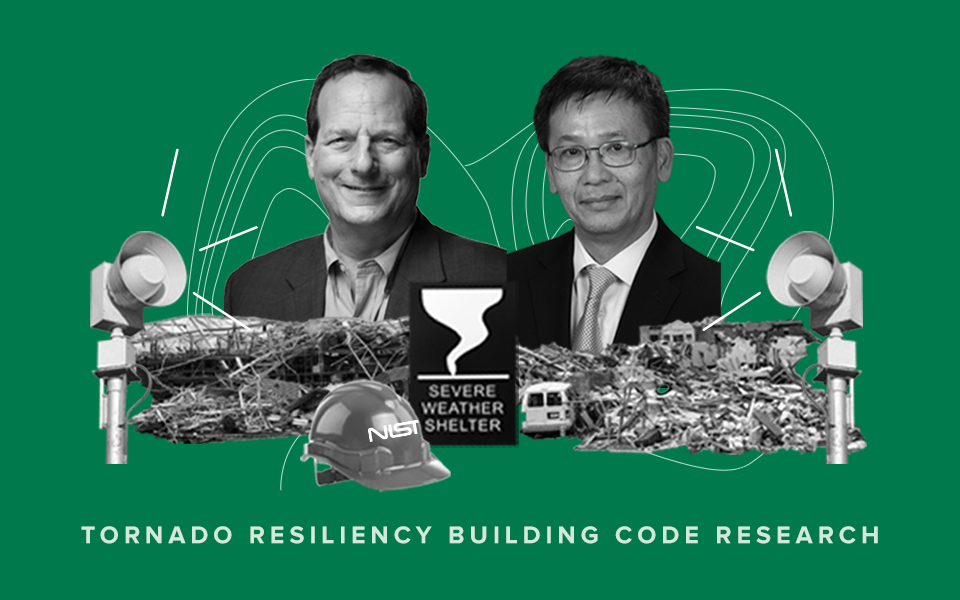NIST’s Long Phan and Marc Levitan Receive Service to America Medal

Credit: B. Hayes/NIST
Long Phan and Marc Levitan, research structural engineers specializing in windstorm impact reduction at the U.S. Department of Commerce’s National Institute of Standards and Technology (NIST), have won the Samuel J. Heyman Service to America Medal in the category of Science, Technology and Environment.
Every year, the Partnership for Public Service awards medals in seven categories to candidates selected from across the federal government to recognize their innovative efforts to save lives and deliver critical services to the public. These awards are commonly known as the “Sammies” and are thought of as “the Oscars of public service.”
The award recognizes Phan and Levitan’s decades-long effort to develop standards and building codes to make structures resistant to tornadoes. Communities across the U.S. have already started adopting these standards and codes to protect critical facilities like schools, hospitals and emergency response facilities from the vast majority of tornadoes.
“We are extremely proud of Long and Marc’s accomplishments, and this award is very well deserved,” said NIST Director Laurie E. Locascio. “The standards and building codes they helped develop and advocate for will have lasting effects long into the future, making our communities safer and saving countless lives.”
When Phan first joined NIST more than 40 years ago, the common belief was that tornadoes were too powerful to design buildings to resist. “Engineers thought tornado windspeeds were so high, there’s no way we can economically design structures to withstand them,” he said.
But that thinking started to change around 1997. After investigating damage from a devastating tornado in Jarrell, Texas, Phan and his NIST colleagues suspected that the way tornado severity was measured, the Fujita Scale, overestimated the strength of tornadoes. He was instrumental in the effort to create a more accurate scale for measuring tornado severity, the Enhanced Fujita Scale. This new scale showed that most tornadoes have windspeeds below 135 miles per hour — a windspeed that buildings can readily be built to withstand — paving the way for the first standards and building codes for tornadoes.
Tornadoes 101 with Marc Levitan
Levitan joined Phan at NIST in 2011, just months before the deadliest tornado on official records touched down in Joplin, Missouri. He, Phan, and a team from NIST conducted a long-term investigation into the disaster. After their investigation, they came up with a plan to reduce the impacts of future windstorms. They worked with local communities, industry and researchers to develop new standards that would protect buildings from tornadoes.
Thanks in large part to their efforts, the 2024 edition of the International Building Code (IBC), for the first time, contains requirements for tornado resistance. The IBC is the blueprint most jurisdictions use to create local building regulations. As communities adopt the new model code, Levitan and Phan’s work will make its way into critical infrastructure across the U.S., securing those buildings against the dangers of the tornadoes they are likely to encounter.
This award also recognizes the significant contributions of the “Tornado Wind Loads Team,” which includes the scores of engineers, scientists and support staff from NIST, other federal government agencies, academia, and the private sector who participated in this effort. This work included the technical investigation of the 2011 Joplin tornado and study of the 2013 Moore, Oklahoma, tornado; research to better understand tornado hazards and their effects on buildings; and collaboration with codes and standards committees to translate the research into building code provisions.
This work is part of NIST’s long history of improving the quality of life and increasing the resilience of U.S. communities prone to natural disasters. NIST leads federal efforts in this area through the National Windstorm Impact Reduction Program (NWIRP) and the National Earthquake Hazards Reduction Program (NEHRP). These programs facilitate collaboration among industry, academia and government agencies to meet critical national needs.
The in-person awards ceremony will be held on Wednesday, Sept. 11, 2024, at the John F. Kennedy Center for the Performing Arts in Washington, D.C.
Samuel J. Heyman Service to America medalists are chosen by a selection committee composed of leaders from government, business, charitable organizations, academia, entertainment and media. For further information, visit the Service to America website.
Legal Disclaimer:
EIN Presswire provides this news content "as is" without warranty of any kind. We do not accept any responsibility or liability for the accuracy, content, images, videos, licenses, completeness, legality, or reliability of the information contained in this article. If you have any complaints or copyright issues related to this article, kindly contact the author above.
